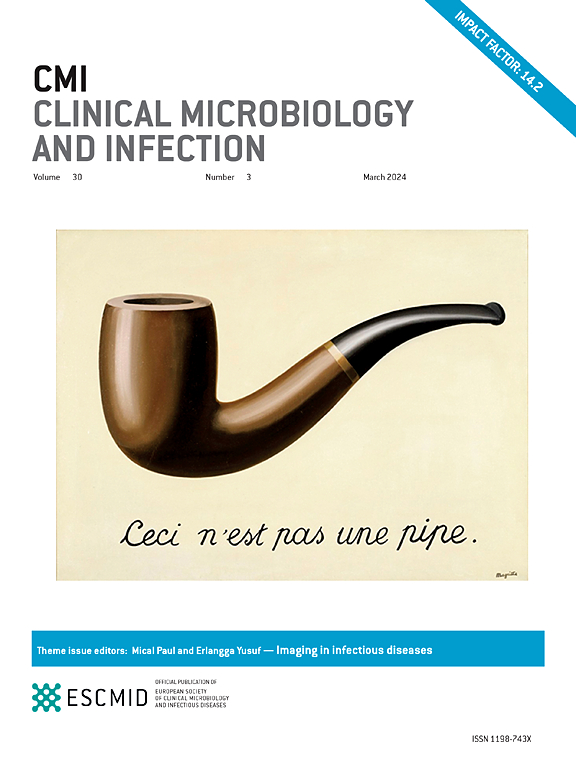医院获得性血流感染经验性抗生素治疗的充分性对重症监护病房患者预后的影响:利用 Eurobact2 研究数据的因果推论方法。
IF 8.5
1区 医学
Q1 INFECTIOUS DISEASES
引用次数: 0
摘要
目的:重症监护病房(ICU)中的医院获得性血流感染(HA-BSI)是威胁生命的常见病。我们希望研究在发生 HA-BSI 后存活至少 1 天的 ICU 患者中,早期充分的抗生素治疗与 28 天死亡率之间的关系:我们使用了一项前瞻性、观察性、多中心、洲际队列研究(Eurobact2)中的个体数据。我们纳入了随访时间≥1天、可获得适当治疗时间的患者。我们使用调整后的虚弱-Cox 比例危险模型来评估治疗充分时间对 28 天死亡率的影响。通过有向无环图(Directed Acyclic Graph)将感染和患者相关变量确定为混杂因素,并将其用于调整。24 小时内的充分治疗用于主要分析。对 48 小时和 72 小时内的充分治疗以及已确定的患者亚组进行了二次分析:结果:在全球 330 个中心收治的 2418 名患者中,HA-BSI 感染发生后 24 小时内接受充分治疗的患者 28 天死亡率为 32.8%(n=402/1226),治疗不充分的患者 28 天死亡率为 40%(n=477/1192)(p结论:在重症监护病房收治的 HA-BSI 患者中,24 小时内治疗不当的 28 天死亡率 PAF 为 9.15%。在假设任何旨在缩短 HA-BSI 患者接受适当抗菌治疗时间的干预措施可能带来的益处时,应使用这一估计值。本文章由计算机程序翻译,如有差异,请以英文原文为准。
Effect of adequacy of empirical antibiotic therapy for hospital-acquired bloodstream infections on intensive care unit patient prognosis: a causal inference approach using data from the Eurobact2 study
Objectives
Hospital-acquired bloodstream infections (HA-BSI) in the intensive care unit (ICU) are common life-threatening events. We aimed to investigate the association between early adequate antibiotic therapy and 28-day mortality in ICU patients who survived at least 1 day after the onset of HA-BSI.
Methods
We used individual data from a prospective, observational, multicentre, and intercontinental cohort study (Eurobact2). We included patients who were followed for ≥1 day and for whom time-to-appropriate treatment was available. We used an adjusted frailty Cox proportional-hazard model to assess the effect of time-to-treatment-adequacy on 28-day mortality. Infection- and patient-related variables identified as confounders by the Directed Acyclic Graph were used for adjustment. Adequate therapy within 24 hours was used for the primary analysis. Secondary analyses were performed for adequate therapy within 48 and 72 hours and for identified patient subgroups.
Results
Among the 2418 patients included in 330 centres worldwide, 28-day mortality was 32.8% (n = 402/1226) in patients who were adequately treated within 24 hours after HA-BSI onset and 40% (n = 477/1192) in inadequately treated patients (p < 0.01). Adequacy within 24 hours was more common in young, immunosuppressed patients, and with HA-BSI due to Gram-negative pathogens. Antimicrobial adequacy was significantly associated with 28-day survival (adjusted Hazard Ratio (aHR), 0.83; 95% CI, 0.72–0.96; p 0.01). The estimated population attributable fraction of 28-day mortality of inadequate therapy was 9.15% (95% CI, 1.9–16.2%).
Discussion
In patients with HA-BSI admitted to the ICU, the population attributable fraction of 28-day mortality of inadequate therapy within 24 hours was 9.15%. This estimate should be used when hypothesizing the possible benefit of any intervention aiming at reducing the time-to-appropriate antimicrobial therapy in HA-BSI.
求助全文
通过发布文献求助,成功后即可免费获取论文全文。
去求助
来源期刊
CiteScore
25.30
自引率
2.10%
发文量
441
审稿时长
2-4 weeks
期刊介绍:
Clinical Microbiology and Infection (CMI) is a monthly journal published by the European Society of Clinical Microbiology and Infectious Diseases. It focuses on peer-reviewed papers covering basic and applied research in microbiology, infectious diseases, virology, parasitology, immunology, and epidemiology as they relate to therapy and diagnostics.

 求助内容:
求助内容: 应助结果提醒方式:
应助结果提醒方式:


